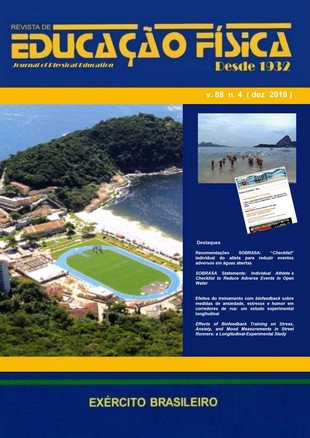Abstract
Introduction: In 1988, the Brazilian Renata Agondi, 25 years old, died while crossing the English Channel. In 2010, American Franz Cripen, vice-champion of world aquatic marathon, died during an open water swimming event. Such fatalities provoked changes in the safety of evidence in open waters, but still with unsatisfactory results. In recent years, there has been an increase in the number of incidents and deaths in training and competitions.
Objective: To present the pre-participation evaluation instrument in a sporting event in open waters of the Brazilian Rescue Society (Sociedade Brasileira de Salvamento: SOBRASA). It is a self-questionnaire in “checklist” format with simple answers’ options (Yes/No), which allows the athlete to evaluate, before participation, the safety of the event.
Conclusion: To develop the questionnaire, a focus group was formed consisting of 16 specialists (health and sports professionals, military firefighters and athletes from open water events) who sought to list and discuss the variables involved in holding a swimming in open water event, and additionally to identify ways to reduce them. In despite of all the safety precautions observed in this type of event, there is no possibility to guarantee 100% protection. In this context, it is up to the organizers and the athlete / competitor to carefully consider the risks involved in participating in the event, seeking to reduce them in order to avoid undesirable incidents.
[Full text in English available]
References
SOBRASA, Szpilman D. Afogamento – Boletim epidemiológico no Brasil – Ano 2019 (ano base de dados 2017 e outros). [Online] [Accessed: 16th May 2020]. Available from: https://www.sobrasa.org/afogamento-boletim-epidemiologico-no-brasil-ano-2019-ano-base-de-dados-2017-e-outros/ [Accessed: 16th May 2020]
Szpilman D, Bierens JJLM, Handley AJ, Orlowski JP. Drowning. New England Journal of Medicine. [Online] Massachusetts Medical Society; 2012;366(22): 2102–2110. Available from: doi:10.1056/NEJMra1013317
Vago H, Szabo L, Czimbalmos CS, Dohy ZS, Csecs I, Toth A, et al. 4251 Results from the Hungarian Cardiac Magnetic Resonance Registry of Structural Heart Disease and Aborted Sudden Cardiac Death in Athletes. European Heart Journal. [Online] Oxford Academic; 2019;40(Supplement_1). Available from: doi:10.1093/eurheartj/ehz745.0134 [Accessed: 16th May 2020]
Wisten A, Borjesson M, Krantz P, Stattin EL. 4100Exercise related sudden cardiac death in the young in Sweden 2000–2010 – a nationwide study showing decreasing incidence in competitive athletes. European Heart Journal. [Online] Oxford Academic; 2019;40(Supplement_1). Available from: doi:10.1093/eurheartj/ehz745.0112 [Accessed: 16th May 2020]
Pelliccia A, Adami PE, Caselli S. Olympic athletes and sudden cardiac death risk. European Heart Journal. [Online] Oxford Academic; 2017;38(27): 2092–2094. Available from: doi:10.1093/eurheartj/ehx349
Szpilman D, Pinheiro A, Madormo S. Drowning perception risk table. World Conference on Drowning Prevention - ILS. Vancouver; 2017. p. 105.
SOBRASA. Recomendação SOBRASA – Segurança em evento de águas abertas. [Online] SOBRASA – Sociedade Brasileira de Salvamento Aquático. Available from: http://www.sobrasa.org/recomendacao-sobrasa-seguranca-em-evento-de-aguas-abertas/ [Accessed: 30th July 2019]
American College of Sports Medicine. ACSM’s Guidelines for Exercise Testing and Prescription. 10th ed. Philadelphia: LWW; 2017. 480 p.
- Autores mantém os direitos autorais e concedem à revista o direito de primeira publicação, com o trabalho simultaneamente licenciado sob a Licença Creative Commons Attribution que permite o compartilhamento do trabalho com reconhecimento da autoria e publicação inicial nesta revista.
- Autores têm autorização para assumir contratos adicionais separadamente, para distribuição não-exclusiva da versão do trabalho publicada nesta revista (ex.: publicar em repositório institucional ou como capítulo de livro), com reconhecimento de autoria e publicação inicial nesta revista.
- Autores têm permissão e são estimulados a publicar e distribuir seu trabalho online (ex.: em repositórios institucionais ou na sua página pessoal) a qualquer ponto antes ou durante o processo editorial, já que isso pode gerar alterações produtivas, bem como aumentar o impacto e a citação do trabalho publicado.
